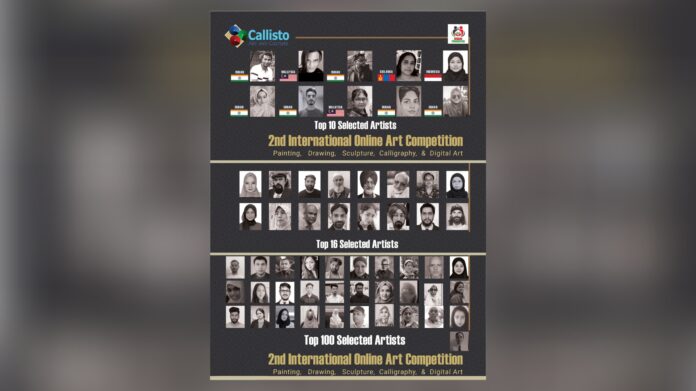Srinagar: Amidst a world that continues to be divided by politics, borders, and challenges, the Valley of Kashmir provided an unlikely stage for a global celebration of art. Callisto Art & Culture’s 2nd International Online Art Competition in partnership with Ehsaas Foundation NGO Kashmir provided a space where more than a hundred artists from across nine countries came together and transformed the virtual platform into an obstacle-less gallery of imagination.
The event was conceived by Kashmiri visual artist Zahoor Kashmiri, founder of Callisto Art & Culture, who has always worked towards establishing avenues for cultural exchange and appreciation of art. “This competition has opened doors for participants from across the globe, providing Kashmiri artists with a chance to showcase their excellence at the international platform,” Zahoor asserted. “The best way to achieve your target is never to lose hope—keep trying, and success will follow.”
The partnership with Ehsaas Foundation NGO Kashmir, which is celebrated for Sufi ideas, cultural empowerment, and social welfare, spiritualized and socialized the competition. Vice Chairman Burhan Nazir thanked the jury and the participants and said that the competition reflected Kashmir’s desire to grow as a center of cultural diplomacy.
The panel for the jury comprised great names from across the globe. Prof. Zargar Zahoor, former Dean of Fine Arts at Jamia Millia Islamia, characterized the competition as being a harmonious mix of style and technique. Turkish artist Dr. Ceyhun Konak toasted the multicultural energy of the paintings, and Mexican painter Carlos Miguel Ramirez dubbed it “a virtual window into the cultures of the world.” Peruvian Daniel Gallegos Esquivias supplemented by stating that the event forged significant global connections at a time when people can’t really go anywhere. Locally, University of Kashmir Cultural Officer Shahid Ali Khan clarified that efforts such as these maintain creativity alive while mainstream institutions remain closed.
Kashmir was also sufficiently represented among highlighted artists. Mehak Mubeen exhibited Homeward and Sacred Threshold, while Syed Mursaleen exhibited Flux I & II. Dr. Zargar Adil Ahmad exhibited Impressions I & II, while Mudasir Rehman Dar exhibited his contemplative Peace Series. Asif Iqbal Khan presented Untitled and Surah Iklas, and Riyan Rafiq presented Islamic calligraphy. Suhaib Ahmad Hakeem, presenting two untitled paintings, Noureen, Enduring Patience and Divine Unity, Mir Andleeb, When Eyes Can’t Hold It Anymore and Salaam, Irtiqa Bazaz, The Eye of Dreams and Whispers of the Universe, Irtiza Sharief, Inside the Eyes and Eye Gaze, and Inju Hussain, Islamic calligraphy on canvas, were other Kashmiri artists.
Indian submissions from outside the state of Kashmir were impressive as well. Md Anirul Islam submitted Holy Bird-II and Tranquility-III, Karan Sharma submitted Khwahisho Ki Khidkiyan and Rozi Roti. Ya Hayy Ya Qayyum and Kaaba were submitted by Shabnam Rajpoot, Sureh al-Fatiha submitted by Shrieen Naaz and Astrolabe in Islam, and Sonjaye Maurya submitted Unity in Diversity and Universe. Jamal Ahmed Shamsuddoha exhibited Aytal Kursi and Dua, Surah Al-Baqarah, Jaspreet Mohan Singh exhibited Divine Lights and The Visionary, M. Akram Khan exhibited Nature I & II, and Neeraj Raina exhibited The Bull I & II. The series was succeeded by Shahed Pasha (King with his Soldiers, Lav Kush), Sualeha Khan (Serenity, Pond), Sumaid Pal Singh Baksh (The Departure, The Veil), and Zuhaib Wahid (Throne Verse, Echoes of an Infinite).
We received a colorful series of works from Malaysia. Hairol Masri Nokhil exhibited Perpetuity & Towards Immortality and Home of Clowder. Eda Tan Sew Lan presented Loving Couple and Strive, while Ain Yusof presented Fruits at Ease and Lotus Symphony. Nur Aniyah binti Anuar presented Tradition in Motion and Ngajat and Datun Julud, while Qaisarah Zainal wowed with Where the Light Found Me and Roads of Adaptation. Rozanah bt Ahmat presented Line and Beauty I & II.
Sri Lanka’s Chandani Jayathilaka showed Women I & II, and Sarath Gunasiri Perera showed Freedom Search I & II. Indonesia’s Tsabita Saifana took center stage with My Safe Place, My Warzone and Frogs and Lily Pads. Bangladesh was represented by Shah Raihan Sani, who showed The Kalimah and Ishq. Egypt’s Safaa Afifi showed untitled acrylic paintings, and from Pakistan, Maryam Kaleem Paracha showed two untitled acrylic paintings.
The variety of themes and styles imbued the competition with its own character. There were those who used cultural heritage, like Islamic calligraphy from India’s Kashmir and Bangladesh. Some used contemporary concerns and individual experience, as indicated by Indonesia’s My Safe Place, My Warzone or India’s Unity in Diversity. From the deployment of the traditional media like charcoal and acrylic to digital experiments, the competition was turned into a kaleidoscope of worldwide artistic practice.
Curator Tasaduq Hussain elaborated the premise behind the campaign: “When Covid had closed art schools and galleries, the artists felt left out. This competition, under the patronage of Ehsaas Foundation, kept the spark of imagination alive and earned them accolades on an international level.”
The 2nd International Online Art Competition was thus not just about ranking or popularity. It was about hope, inclusivity, and determination. For Kashmir, it was also about re-positioning itself to the world in the space of creativity and not conflict.
As Zahoor Kashmiri succinctly framed it: “By art, we express ourselves, but better, we connect humaneness. Having Ehsaas Foundation as our sponsor, this competition was a genuine celebration of global creativity.”

